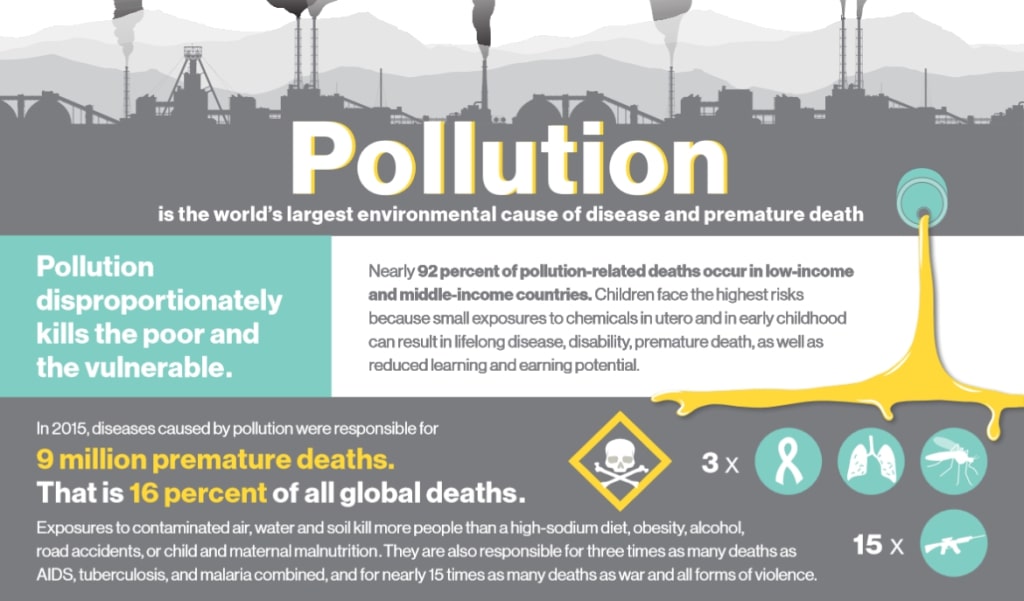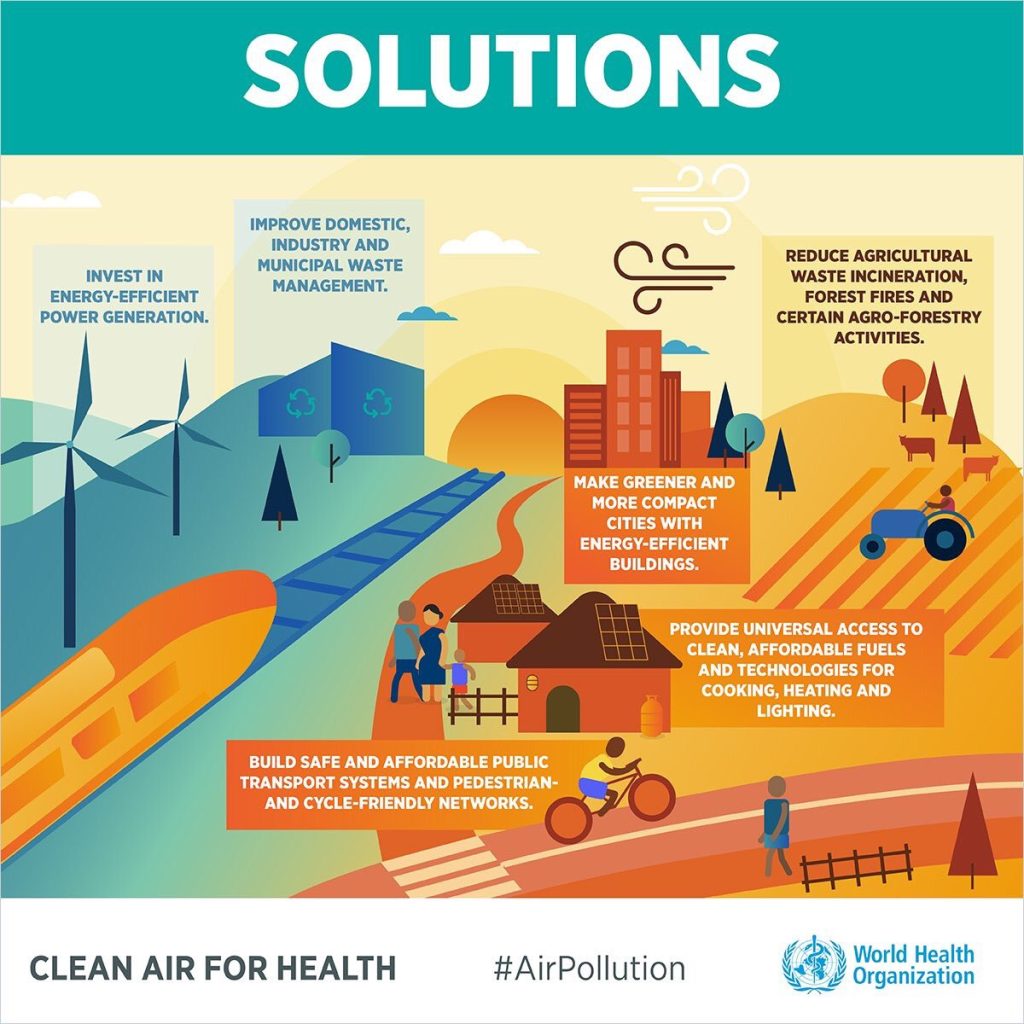CONTENTS:
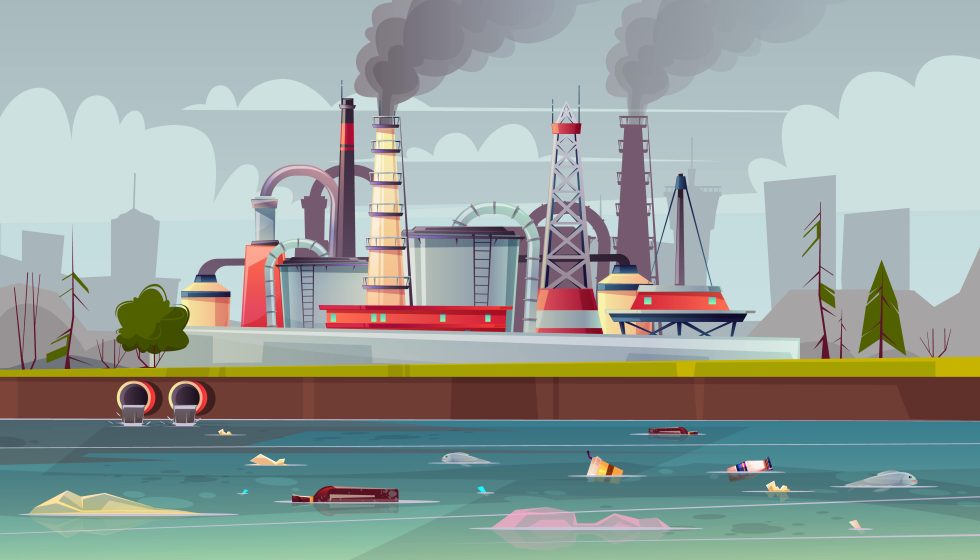
CONTENTS:
Pollution isn’t new. We’ve been fighting against the contamination of the earth’s soil, water, and air for decades.
Government regulations have helped turn the tide against some types of pollution, but fail to keep up with the new stream of pollutants contaminating our world.
New toxic waste sources continue to arise.
From the rising tide of e-waste — composed of old printers and other electronic devices — to the continued destruction of environmentally sensitive rainforests, the latest pollution statistics show that more must be done to clean up our planet.
What is Pollution?
Pollution occurs when harmful contaminants are released into the environment, negatively affecting human health and well-being.
This can be anything from trash littered from passing cars to harmful chemicals being released into the environment as a result of manufacturing.
- Pollution affects 100 million people, making it one of the world’s most deadly hazards, comparable to diseases like HIV and malaria.
- Cruise and cargo ships dump more than 14 billion pounds of garbage into the ocean.
- One million seabirds and 100,000 marine mammals die annually as a result of pollution.
- Outdoor air pollution is responsible for 10% of all lung cancer cases.
- 1.5 million metric tons of nitrogen pollution from the Mississippi River floods the Gulf Of Mexico each summer, creating an environmental “dead zone” roughly the size of New Jersey.
- 40% of American lakes are too polluted for fishing or swimming.
- The United States makes up 5% of the global population, yet consumes more than 24% of natural resources like gas, coal, and oil.
- 1.2 trillion gallons of industrial waste and sewage are dumped into US water sources annually.
- 1.7 million kids under age 5 die every year from environmental factors.
There are several different types of pollution, but today we are going to touch on the three major types: land, water, and air pollution.
Other types of pollution include noise, visual, light, thermal, and plastic.
Land Pollution
Land pollution is when our waste is not disposed of properly, resulting in soil and groundwater contamination.
Agricultural practices that use pesticides and fertilizers also cause land pollution that threatens public health.
- 75% of the land on earth is polluted to some degree.
- 95% of the land on earth will be polluted by 2050 if current environmental trends continue.
- 3.2 billion people across the globe are impacted by land pollution.
- 87% of global wetlands have been degraded since 1900.
- Half of the world’s population does not have access to proper waste disposal.
- There are 1,270 landfills in the United States.
- 80% of urban waste can be diverted from landfills.
- 60 million people live within 10 kilometers of the world’s biggest landfills.
- Open landfills are responsible for 91% of hazardous methane emissions.
- 20.8% of the soil in China is so polluted it poses a cancer risk to children.
- 700,000 deaths each year are attributed to land pollution.
- The United States recycled 69 million tons in 2018, a recycling rate of approximately 24%.
- Paper and cardboard make up 67% of recycled materials.
The Effects Of Land Pollution
Land pollution begins with the contamination of soil by harmful chemicals, but it doesn’t end there.
Oftentimes these toxins are carried off-site by rainwater runoff and end up contaminating water sources.
Other times a buildup of land pollution can also affect air quality. Not only does land pollution affect water and air quality, but it also taints the soil used for farming, increases the risk of wildfires, and threatens wildlife.
Land contamination can come from a variety of sources.
Abandoned mines and manufacturing facilities, improper waste disposal, and the use of harmful pesticides and fertilizers are a few of the main offenders.
Land pollution is responsible for:
- Soil contamination. In wet regions, harmful toxins are leached into the water table. In dry areas, toxins become airborne dust.
- Human health issues related to exposure to land pollutants.
- Wildlife deterioration as land pollution impacts the food chain and natural habitats.
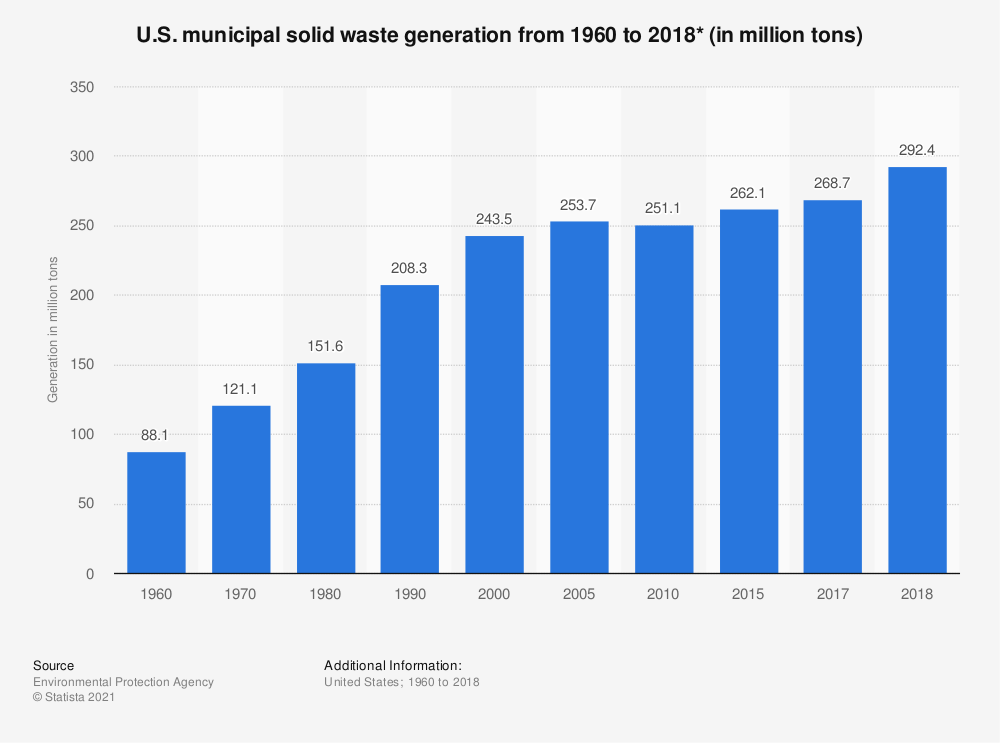
Water Pollution
Water pollution occurs when bodies of water — such as lakes, rivers, and oceans — are contaminated by toxic substances such as chemicals or microorganisms.
Water contamination is widespread and poses a major health risk.
- 2.2 billion people — one-third of the global population — do not have access to safe drinking water.
- More deaths are caused annually by unsafe drinking water than any form of violence, including war.
- 1.8 billion people around the world are affected by sewage and industrial chemicals polluting water supplies.
- By 2040, the entire Middle East and South Asia, as well as large portions of China and North Africa will be under severe clean water shortages due to pollution and climate change.
- 80% of the world’s sewage is released into the environment without proper treatment.
- 8% of ocean pollution is attributed to chemicals, nutrients, and toxic metals.
- $22 billion is spent annually on global sewage treatment.
- 40 billion liters of sewage get dumped into the lakes and rivers of India every day.
- 55% of the world’s population lacks proper sanitation.
- 33% of healthcare facilities in low-income countries use polluted water.
Water Pollution In The United States
Although most Americans have access to safe drinking water, harmful contaminants (copper, lead, etc.) have been found in many major cities across the North American continent, according to the National Resources Defense Council.
- 10% of American beaches are not safe for swimming due to pollution.
- 76% of wastewater collected in American sewers is safely treated.
- 34 billion gallons of wastewater are processed in the United States every day.
- Tap water in every US state contains some type of contamination, from arsenic to copper.
- 80,000 Safe Drinking Water violations were reported in the United States in 2015.
Different Types Of Water Pollution
Water is able to dissolve substances easier and faster than any other liquid which is why water can be polluted so easily.
Toxins that come from farms, towns, and factories will easily dissolve into the water and cause water pollution.
- Groundwater – This occurs when pesticides, fertilizers, and other chemicals are driven deep into the soil by rainwater, tainting underground water reserves and wells.
- Surface water – is defined as lakes, rivers, streams … any body of water on the surface of the earth is considered surface water. Toxic chemicals settling and dissolving in surface water causes surface water pollution.
- Ocean water – is polluted by the daily dumping of trash and plastics as well as unplanned disasters like oil spills.
- Point source – occurs when you can readily identify the source of regional pollutants, like a smokestack or drainage ditch.
- Nonpoint source – this comes from many different pollution sources that move from their original location, like melting snow that carries pollutants from the source to a river or lake.
- Transboundary – this type of pollution originates in one country but impacts another country either through air or water currents.
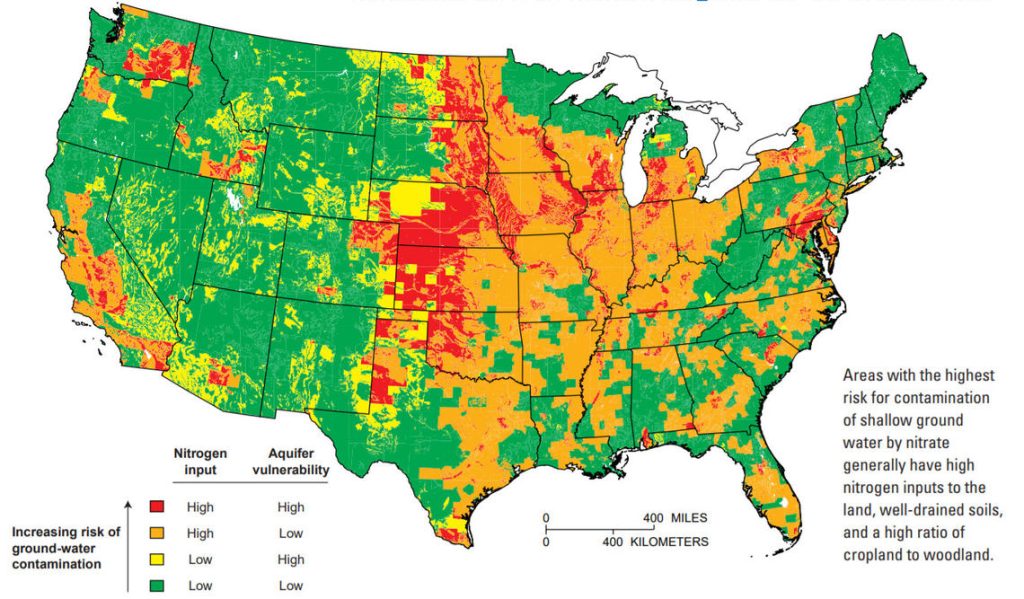
The Most Common Water Contaminants
Water pollutants can come from anywhere and everywhere.
These are the four most common types of water contamination.
- Agricultural – this occurs when rainwater washes soil from farms into nearby lakes and streams. Even if the soil particles are free of contaminants, they can accumulate in the water and block sunlight, prohibiting the growth of aquatic plants.
- Sewage and wastewater – sewage contains urine, feces, and solid waste, while wastewater contains “gray water” from laundry machines and dishwashers. Sewage and wastewater contain many contaminants that are harmful to human health.
- Oil pollution – happens on the world’s oceans from oil tanker spills, run-off, and daily shipping procedures. Oil does not dissolve in water and forms a thick sludge on the surface that is hazardous to sea life.
- Radioactive substances – certain radioactive substances occur naturally in groundwater, like radium, thorium, and uranium. In trace amounts, they are not harmful to human health. However, accumulations of radioactive substances in water are quite dangerous and can increase the risk of cancer, and may harm fetal development.
The Effects Of Water Pollution
According to David Malpass, president of the World Bank, water pollution directly impacts global economic growth and increases poverty levels.
Areas with polluted water have one-third less Gross Domestic Product (GDP) growth compared to countries with potable water.
Water pollution is also responsible for:
- Decreased biodiversity and disruption of ecosystems in rivers and lakes.
- Food chain contamination when fish are pulled from polluted water and polluted water is used for agriculture and livestock farming.
- Potable water shortage as water sources in rural areas become contaminated. Diseases spread rapidly when communities have no access to potable water.
- An increase in infant mortality rates due to contaminated water. The United Nations estimate 1,000 die each day around the world due to polluted water.
Air Pollution
Most air pollution is caused by burning fossil fuels that release gas and chemicals into the air.
This pollution is detrimental to both human health and to planet earth.
- People of color are three times more likely to be subject to air pollution than white people.
- 2021 ranks one of the six hottest years on record. Temperature spikes lead to elevated particle pollution and increase wildfire risks.
- 135 million Americans (41.1%) live in areas with unhealthy pollution levels, an improvement over 2019/2020 when 149.8 million Americans lived in areas with unhealthy pollution.
- Los Angeles remains the city with the worst ozone pollution in America, as it has for all but one of the last 22 years.
- 3-out-of-8 Americans live in areas that score an “F” for ozone pollution.
- Nearly 21 million Americans (6.4% of the population) live with year-round particle pollution.
- Approximately 54.4 million people live in areas with unhealthy spikes in particle pollution.
- Particle pollution can lead to early death, heart attacks, and strokes.
- People with asthma and cardiovascular disease suffer the most from particle pollution
- 23 of the 25 cities with the worst short-term particle pollution are located in the western United States.
- Fairbanks, Alaska has the worst short-term particle pollution in America, mostly due to wildfires.
- The populations most at risk for air pollution are people of color, people living with poverty, as well as children and the elderly.
- 7 of the 10 regions with the worst annual air pollution are located in California. Two are located in Oregon and the other is Fairbanks, Alaska.
The American cities with the lowest air pollution levels are:
- Burlington, VT
- Charlottesville, VA
- Elmira-Corning, NY
- Honolulu, HI
- Wilmington, NC
The Effects Of Air Pollution
Smog and soot are made up of tiny particles, often derived from burning fossil fuels in automobiles and manufacturing facilities.
Air pollution is particularly dangerous since contaminants breathed in by the lungs can be absorbed directly into the bloodstream.
In worst-case scenarios, this can lead to bronchitis, heart attacks, and even death.
In addition to damaging the lungs, smog irritates the eyes and throat.
Greenhouse gases have an effect on temperature and climate change.
The earth’s heat is trapped in the atmosphere which then results in sea levels rising, extremely hot weather, and the ability for infectious diseases to spread rapidly.
In addition, climate change has also been linked to an increase in hazardous airborne mold and pollen.
What Can You Do to Prevent Pollution?
The answer is simple — we all need to live a more sustainable life in order to reduce pollution and treat our earth better.
By reducing the use of Earth’s natural resources and using only our personal resources we can do this collectively.
Preventing Land Pollution
The best thing we can do to protect our land from pollution is reforestation.
A complete ecosystem supports many habitats. Construction, mining, and deforestation expose the soil to more contaminants.
The more trees we plant the better chance we have of protecting our land.
Here are a few things you can do:
- Use fewer pesticides and chemicals
- Be mindful of your electricity consumption by turning off and unplugging devices that aren’t being used, such as printers
- Use LED bulbs instead of fluorescent and turn off the lights that aren’t in use
- Use energy-efficient appliances
- Consider purchasing your electricity from renewable sources or install solar panels in your home and/or office
Preventing Water Pollution
Curbing water pollution takes a concerted effort.
Habits don’t change overnight, but a consistent, conscientious approach can make a drastic difference in the world.
Here are a few things you can do:
- Reduce your plastic consumption by reusing and recycling plastic whenever possible
- Check your car often to ensure it’s not leaking oil, antifreeze, or coolant
- Avoid using pesticides and herbicides on your lawn
- Pick up after your dog
If you witness anyone else not taking care of our earth, feel free to speak up. Sometimes we just need a friendly reminder.
Preventing Air Pollution
I’m sure you have heard of carpooling before and the benefits of it!
Vehicle emissions are an extreme cause and problem of pollution.
When we limit the gasoline burned we can reduce air pollution and the harmful effects it causes on the environment and to our health.
Try to carpool, walk, bike, or take public transportation whenever possible to limit pollution from vehicle emissions.
A simple way to support the importance of decreasing our air pollution is to be mindful of the companies you purchase from and the leaders we have.
Do they support and push for clean air and water that are responsible steps for climate change?
The start of a better world begins with small gestures by you!
Further reading:
- Eye-Opening Recycling Statistics [U.S. and Global]
- Surprising Print Advertising and Direct Mail Statistics 2021
- Printing Statistics: Printing by Numbers in 2022
- Best Printers for College Students [Top Picks]
Sources
https://www.thelancet.com/commissions/pollution-and-health
https://www.coastal.ca.gov/publiced/marinedebris.html
https://www.worldwideboat.com/knowledgebase/plastic-pollution-and-marine-life
https://www.cancerresearchuk.org/about-cancer/causes-of-cancer/air-pollution-radon-gas-and-cancer/how-can-air-pollution-cause-cancer
https://www.nature.org/en-us/about-us/where-we-work/priority-landscapes/gulf-of-mexico/stories-in-the-gulf-of-mexico/gulf-of-mexico-dead-zone
https://worldpreservationfoundation.org/environment/water-security/polluted-waters
https://www.scientificamerican.com/article/american-consumption-habits
https://www.epa.gov/sites/default/files/2015-10/documents/csortc1_4.pdf
https://www.who.int/news/item/06-03-2017-the-cost-of-a-polluted-environment-1-7-million-child-deaths-a-year-says-who
https://www.sciencedirect.com/science/article/pii/S0143622814002793
https://www.thegef.org/what-we-do/topics/land-degradation
https://www.nationalgeographic.com/science/article/ipbes-land-degradation-environmental-damage-report-spd
https://www.globalagriculture.org/whats-new/news/en/33099.html
https://www.statista.com/statistics/530481/largest-dump-sites-worldwide
https://www.statista.com/statistics/186256/us-municipal-solid-waste-generation-since-1960
https://www.cnbc.com/2018/07/13/how-san-francisco-became-a-global-leader-in-waste-management.html
https://www.nature.com/articles/nclimate2804
https://www.sciencedirect.com/science/article/abs/pii/S0048969719323320
https://www.fao.org/global-soil-partnership/resources/highlights/detail/en/c/1127952/
https://www.epa.gov/facts-and-figures-about-materials-waste-and-recycling/national-overview-facts-and-figures-materials
https://www.epa.gov/facts-and-figures-about-materials-waste-and-recycling/national-overview-facts-and-figures-materials
https://www.epa.gov/report-environment/contaminated-land
https://washdata.org/sites/default/files/documents/reports/2019-05/JMP-2017-report-final-highlights.pdf
https://www.unicef.org/reports/water-under-fire-2019
https://www.unwater.org/water-facts/
https://www.unwater.org/world-water-development-report-2020-water-and-climate-change
https://oceanservice.noaa.gov/facts/pollution.html
https://www.iwa-network.org/wp-content/uploads/2018/02/OFID-Wastewater-report-2018.pdf
https://www.weforum.org/agenda/2019/10/water-pollution-in-india-data-tech-solution
https://www.afro.who.int/health-topics/water
https://www.nrdc.org/sites/default/files/whatsontap.pdf
https://www.nrdc.org/sites/default/files/ttw2014.pdf
https://www.epa.gov/nutrientpollution/sources-and-solutions-wastewater
https://www.nrdc.org/resources/threats-tap-widespread-violations-water-infrastructure
https://www.un.org/sustainabledevelopment/water-and-sanitation
https://www.iberdrola.com/sustainability/water-pollution
https://www.lung.org/research/sota/key-findings
